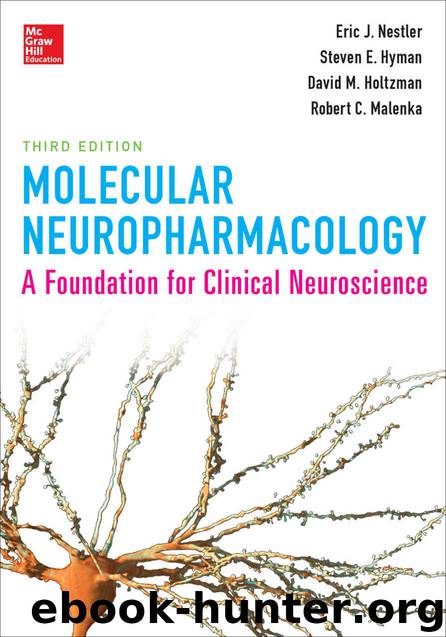Molecular Neuropharmacology: A Foundation for Clinical Neuroscience, Third Edition by Nestler Eric & Hyman Steven & Malenka Robert

Author:Nestler, Eric & Hyman, Steven & Malenka, Robert
Language: eng
Format: epub
Publisher: McGraw-Hill Education
Published: 2015-03-21T16:00:00+00:00
11–5 Neuropathic Pain
Damage to neurons in nociceptive pathways generally causes some loss of normal pain sensation. However, after a delay, such damage can, rather unpredictably, result in neuropathic pain. Neuropathic pain can be produced by several disease processes that injure nociceptive neurons or lead to cell death in either the periphery or the central nervous system. Common causes include postherpetic neuralgia, diabetic neuropathy, nerve compression (including spinal disc disease), or cutting of nerves (as may occur in accidents, amputations, or even in routine surgical procedures). Postherpetic neuralgia, or shingles, is caused by the reactivation of a latent herpes varicella-zoster (chicken pox) virus. This type of virus can remain dormant in primary sensory neurons for decades and become reactivated by unknown mechanisms. Shingles generally affects a single spinal nerve or cranial nerve branch and thus affects a single dermatome. Because of damage to the nerve, persistent and sometimes severe neuropathic pain may result. One well-known and dramatic example of neuropathic pain is trigeminal neuralgia that produces severe lancinating pain in a trigeminal nerve distribution. The cause appears to be compression damage to the trigeminal nerve where it exits the skull. Patients with neuropathic pain may experience allodynia, hyperalgesia, and spontaneous pain, which may include persistent burning, paresthesias such as pins and needles, or unprovoked paroxysms of sharp pain. When trigeminal neuralgia is associated with facial spasms, the syndrome is termed tic douloureux.
Neuropathic pain is initiated by damage to peripheral or central nociceptive neurons. Persistent pain syndromes can therefore result not only from damage to cutaneous nociceptors, as in postherpetic neuralgia, but also from damage to spinal or thalamic neurons involved in nociception. Sensitization of damaged peripheral or central nociceptors is thought to produce high-intensity action potentials that cause plasticity in the higher-order neurons to which they project. One implication is that surgical interruption of damaged peripheral nerves (eg, resection of a neuroma that may form after injury) or lesioning of central structures in an effort to relieve pain may not only prove ineffective but also produce new neuropathic pain on its own account.
Even severed nerves may contribute to central plasticity, not only by releasing K+, H+, and ATP onto surrounding neurons but also as a result of the significant molecular changes that they undergo; a large number of genes are activated or suppressed within the cell body of a deafferented neuron. If these neurons retain their central connections, they may also contribute to the process of sensitization. Indeed, it is still unclear whether central sensitization is due more to the damaged nociceptors or the surrounding nociceptors they influence.
In a rodent model, central sensitization that produces tactile allodynia has been attributed to brain-derived neurotrophic factor (BDNF) released by a highly circuitous route. Damage to peripheral nociceptors may lead, by unknown mechanisms, to activation of microglia in the spinal cord, which then express P2X4 receptors. These respond to ATP stimulation with release of BDNF, which, in turn, sensitizes dorsal horn nociceptive neurons. Whether or not this scenario turns out to be correct, it
Download
This site does not store any files on its server. We only index and link to content provided by other sites. Please contact the content providers to delete copyright contents if any and email us, we'll remove relevant links or contents immediately.
| Administration & Medicine Economics | Allied Health Professions |
| Basic Sciences | Dentistry |
| History | Medical Informatics |
| Medicine | Nursing |
| Pharmacology | Psychology |
| Research | Veterinary Medicine |
The Poisoner's Handbook by Deborah Blum(1982)
Bottle of Lies by Katherine Eban(1706)
Mycelium Running: How Mushrooms Can Help Save the World by Paul Stamets(1582)
The Vaccine Race by Meredith Wadman(1563)
Missing Microbes by Martin Blaser(1521)
Pharmacy Practice and The Law by Richard Abood(1496)
The Doors of Perception and Heaven and Hell by Aldous Huxley & Aldous Huxley(1490)
Decisive by Chip Heath(1457)
Steroids: History, Science, and Issues by Standora Joan E.; Bogomolnik Alex; Slugocki Malgorzata(1427)
28 Seconds by Michael Bryant(1421)
The Doors of Perception: Heaven and Hell (thINKing Classics) by Aldous Huxley(1412)
McGraw-Hill Nurses Drug Handbook by Patricia Schull(1401)
Ganja Yoga by Dee Dussault(1387)
What's Making Our Children Sick? by Michelle Perro(1351)
Complete Guide to Prescription & Nonprescription Drugs 2014 by H. Winter Griffith(1282)
Stealing Fire: How Silicon Valley, the Navy SEALs, and Maverick Scientists Are Revolutionizing the Way We Live and Work by Steven Kotler & Jamie Wheal(1277)
Anatomy of an Epidemic by Robert Whitaker(1238)
Trip by Tao Lin(1234)
Cannabis for Chronic Pain by Rav Ivker(1166)
